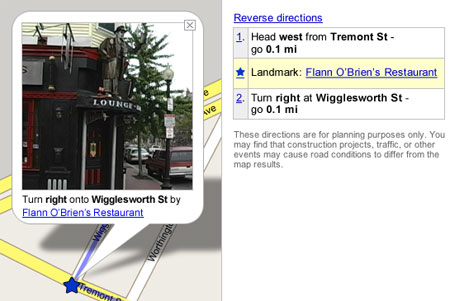Augmenting Google Maps with Landmarks 03-25-2005
The introduction of Google Maps provided a major push in innovating the online maps and directions services, which in turn has opened up new avenues for further innovation in this sector. Introducing visual representations of landmarks within directions can hopefully improve the success rates of correctly following directions.
Cognitive Maps
Research in cognitive psychology suggests that the way in which humans determine position and get around their environments is based upon a construct known as cognitive maps. Such maps can be seen as a mental representation of a person’s surroundings, typically loosely constructed and centering on relationships between landmarks (i.e., buildings, unique objects, etc).
It is not surprising then that a friend might tell you how to get a particular location based around landmarks rather than street names. For example:
To get to the Fenway, drive straight, take a right by Flann O’Brien’s, and then a left by Mass Art.
Directions such as these are based off a person’s cognitive map of the area. Identifying, categorizing, and remembering landmarks is far easier than attempting to read and remember street signs which have weak relationships to the environment. An exception to the case may be areas which have a structured naming convention for streets (e.g., New York City).
This is not to say that specific directions are not needed, but that they can be augmented to reflect how people actually travel and think about their environment.
Improving Google Maps based upon Cognitive Maps
Figure 1 displays a modified version of Google Maps featuring support for landmarks. Using the example provided earlier, the user is now able to get a visual representation of the landmark, Flann O’Brien’s. Thus allowing the user to create relationships between elements of the enviroment.

Figure 1. Google Maps with Landmarks
Potential Revenue Source
The addition of landmarks also provides a potential revenue source. Many landmarks are places of business, which could possibly pay to have additional information displayed. Surprisingly such advertising could actually be useful to the user. They will be traveling to an area which they may be unfamiliar with but may wish to stop at a restaurant or store on the way.